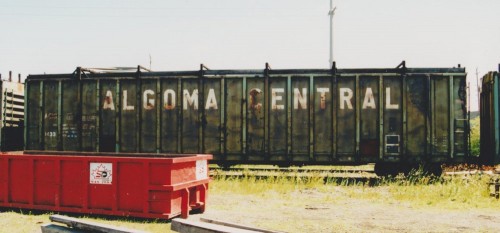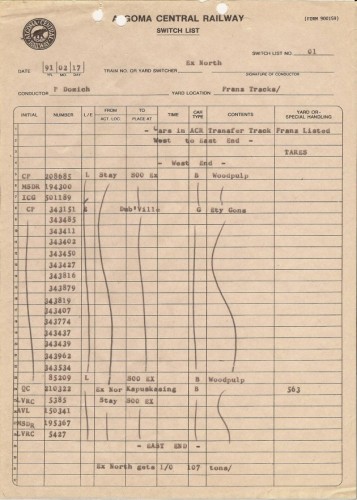Wood chip traffic on the ACR primarily derived from the sawmills and Dubreuilville and Mead. Both mills were large sources of chip traffic – although not at the same time.
Newaygo Forest Products (Mead, ON)
In 1974 Newaygo Forest Products built a new modern mill 20 miles south of Hearst on the ACR at Mead to produce lumber and wood chips for export to the United States. The woodchips would be shipped to a paper mill in Appleton, Wisconsin.
To supply cars for this traffic the Algoma Central purchased 89 cars from National Steel Car in 1974, with unique ACIS reporting marks designating them under some customs rules or regulations for International Service. A further 23 cars with regular AC reporting marks were added in 1980.
These large capacity cars, the biggest cars on the ACR roster and painted a unique pale green colour with yellow end doors and “billboard” lettering cut a striking appearance, and travelling over almost the entire length of the railway and into Michigan and Wisconsin, there are several good photos of both of these car series available.
They seemed to ship up to about half a dozen cars at a time from Mead, and extra empty cars would often be stored in the siding at Horsey or Coppel, on either side of Mead.

ACIS 1433, one of a few survivors from the Algoma Central’s woodchip car fleet at Steelton yard in 2001. Blair Smith photo.
The mill at Mead shut down in 1985 bringing this traffic to an end.
Dubreuil Forest Products (Dubreuilville, ON)
In about 1986 or 1987, Dubreuil Forest Products installed a new chip spur and loader at their mill at Dubreuilville to load woodchips for the pulp mill on the Canadian Pacific at Marathon.
Cars for this service were 52′-60′ gondolas provided from Canadian Pacific. Over 100 cars were provided, with empties stored in the sidings at Goudreau and Wanda north and south of Dubreuilville to protect the loadings at the mill.

1991 switchlist showing cars in the transfer track at Franz. The dozen empty CP 343xxx series gondolas listed are woodchip cars for Dubreuilville.
Despite the large numbers of car loads involved, since they operated only between the interchange at Franz and the mill at Dubreuilville about 10 miles south, and both locations being a bit more than just slightly off the beaten path, this traffic wasn’t too visible and I haven’t seen much in the way of photographs of these cars in ACR trains, unlike the much more visible AC/ACIS woodchip gondolas that were used to service the Newaygo mill. Fortunately the cars have been well photographed in other locations, particularly as many survivors have recently been used in tie service.

A common variation of CP’s woodchip gondolas rebuilt from a 52′ gondola with extended sides. Bill Grandin photo.
During the 1990s, the AC (and later WC) ran an weekday evening “Franz Turn” out of Hawk Junction to switch lumber and chip loads at Dubreuilville and the interchange at Franz.
The mill at Dubreuilville closed in 2007.
Lecours Lumber (Calstock, ON)
After Newaygo shut down their operations at Mead, the fleet of AC and ACIS woodchip cars were sold off, with many cars being transferred to Newaygo for use on other operations.
One place where ex-Algoma Central cars with Newaygo (NFPX) markings seemed to show up regularly in the 1990s and early 2000s was at the Lecours Lumber stud mill west of Hearst, on trackage now operated by Ontario Northland. These chips apparently headed down into the US somewhere, so by a curious twist of fate, these ex-Algoma Central cars continued to operate over the former Algoma Central rails for several years.

NFPX 1511 with a load of woodchips at Steelton yard, 1999. Blair Smith photo.
I’m not sure when this service ended (or if indeed it still continues on a periodic basis) but in my few visits to the area over the last few years I’ve never seen any chip cars.

Do you have any pictures of the facilities that generated wood chips from Pulpwood?
I want to build such a facility on my HO WCL Valley Line railroad.
Sorry Phil for not replying earlier.
Most woodchips were produced as a by-product from waste material at a sawmill, or directly from logs at the paper mill. The chipping machinery would just be a mechanical grinder – a larger version of what a landscaping/tree service crew would use for cleanup.
Chips are then typically blown into the cars pneumatically through pipes. The loading apparatus could be as simple as a blower nozzle (and support structure therefore) above the car, but many also have some sort of protective hood to prevent spraying chips all over the property (although some mess will still be expected around the loadout).
Here’s a good example of an etched brass kit for a woodchip loader with such a hood that lowers above the car to contain the chips being blown in. Piping is added to connect the loader to the building.
http://www.traincat2.com/d_woodchip.htm
Sadly I believe this manufacturer may no longer be selling, but it illustrates quite well. I’ve seen photos of the Lecours mill in Calstock and they have a loader identical to this in concept if not specific details, and lots of photos of similar loaders elsewhere as well.
Google the term “woodchip loader” and browse the image results for a bunch of similar ideas for both truck and railcar loaders. There are much more simplified installations out there as well.
Some of the AC woodchip cars went to Westar Timber in northern BC in the mid to late 1980’s under the reporting mark WESX The company changed names multiple times and the cars lasted in service until late 1990’s when it went belly up. No idea where they went from there.
Thanks for pointing that out Doug.
I have 70 cars from ACIS 1418-1490 to WESX same #s in about 1984. (ACIS 1433 known to NOT have transferred, one or two others probably wrecked.) Later to DCFX same #s, repainted white with a large Skeena logo.
ACIS 1401-1412 went to NFPX (Newaygo) same #s in 1984-85, and about 5 or 6 remaining cars were kept by the AC and modified as lumber cars for Dubreuil Bros.
All of the AC 1501-1523 also to NFPX same #s.
BTW, I also have a Westar wrap in my Lumber Loads page.
Hi Chris
Question !
Do you know the size and height of the cp rail woodchip, is the model of the mlw 52“ (gondola) the base (of rapido train) I think they have a supplementary height of 7 feet more? And For models 343400 you have the size and height. I see nothing on the internet maybe you could help me?
Hi Pascal,
The 343400-499 series specifically is a bit of an odd one out – those are 64’0″ gondolas with a 10’8″ inside height built new in 1969. All of the other 343xxx series cars (there are several different groupings and variations) are rebuilt from 52’6″ gondolas that are either the same as the Rapido trains model or similar but with fixed ends instead of drop ends. Most of them have a 11’0″ inside height; with the original cars having a 3’6″ height, that’s a 7’6″ extension overall.
Ian Cranstone has extensive roster listings of Canadian freight cars at his site (http://nakina.net/cp/cp3.html) and there’s a few good photos here: http://canadianfreightcargallery.ca/cgi-bin/displayrailway.pl?o=cprail&display=short#gondola